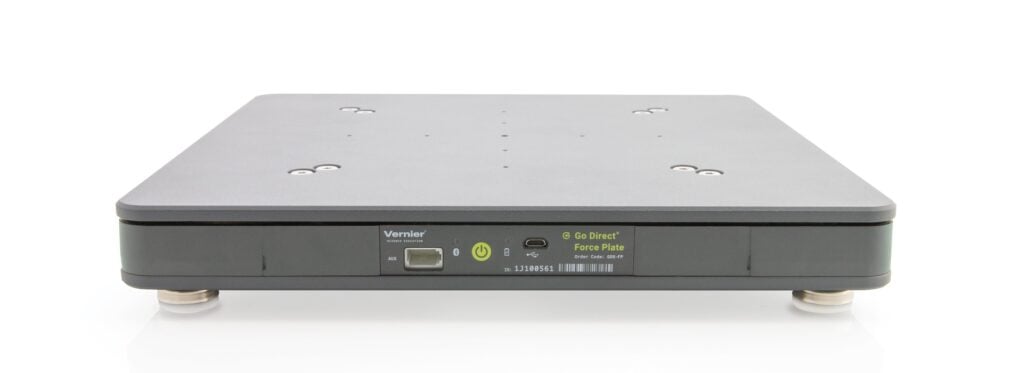TROUBLESHOOTING
- Primary Test: Open the data-collection program and start a new experiment file. Connect the force plate to the software using the USB cable or Bluetooth. Using the default channel (Force), does the plate read approximately zero? Choose Zero in software. Stand on the plate; using F=mg, does the reading make sense?
- Secondary Test: Changing the physical orientation of the sensor will change the reading when no force is applied. Use the tools in the data-collection program to zero the sensor.
If the force plate does not respond to a change in force, try connecting the sensor using the alternate method (USB or Bluetooth). Verify that the battery is charged sufficiently. If plate still does not respond, contact Technical Support. Call 888-837-6437 or email support@vernier.com.
It is common for the force plate to exhibit some hysteresis (on the order of a few newtons) after hard impacts. This can be accounted for simply by zeroing the sensor.
RELATED TIL ENTRIES
- What activities are available for the Force Plate?
- Can I use your equipment for a bridge-building contest?
- How short an impulse can I measure with the Force Plate?
- What does the Force Plate measure?
- Which force plate do I have?
- What is the AUX port and Auxiliary Voltage sensor channel used for on a Go Direct Force Plate?
- How do I switch between Physics and Physiology Sensor Channels on my Go Direct Force Plate?
- Why does my X-axis Balance seem less stable than my Y-axis Balance when using the Go Direct Force Plate?
- How do I use the X-axis and Y-axis Balance channels on a Go Direct Force Plate?
- Can you use a Force Plate with a Texas Instruments calculator?
SPECIFICATIONS
- Force range: -350 to +3500 N, where positive value is a compression force
- Maximum non-damaging force: 4500 N (1000 lb) compression
- Dimensions: New version: 31.5 cm x 31.5 cm x 3.5 cm
CALIBRATION
- Calibrate? No. The sensor is set to the stored calibration before shipping.
If you wish to calibrate the sensor, you will conduct a two-point calibration. The first point is zero. Set the Force Plate on a level surface and remove all force from the Force Plate. Enter 0 (zero). Second point: apply a known force (known mass) to the Plate. To obtain a good calibration, the weight should be at least 25% of the range used for the plate (850 N) if possible. Enter the weight of the mass (note: 1 kg weighs 9.8 N). Be careful not to exceed the selected range setting during the calibration.
RELATED VERNIER PRODUCTS
- Force Plate Handles (FP-HAN)
- Force Plate (FP-BTA)

